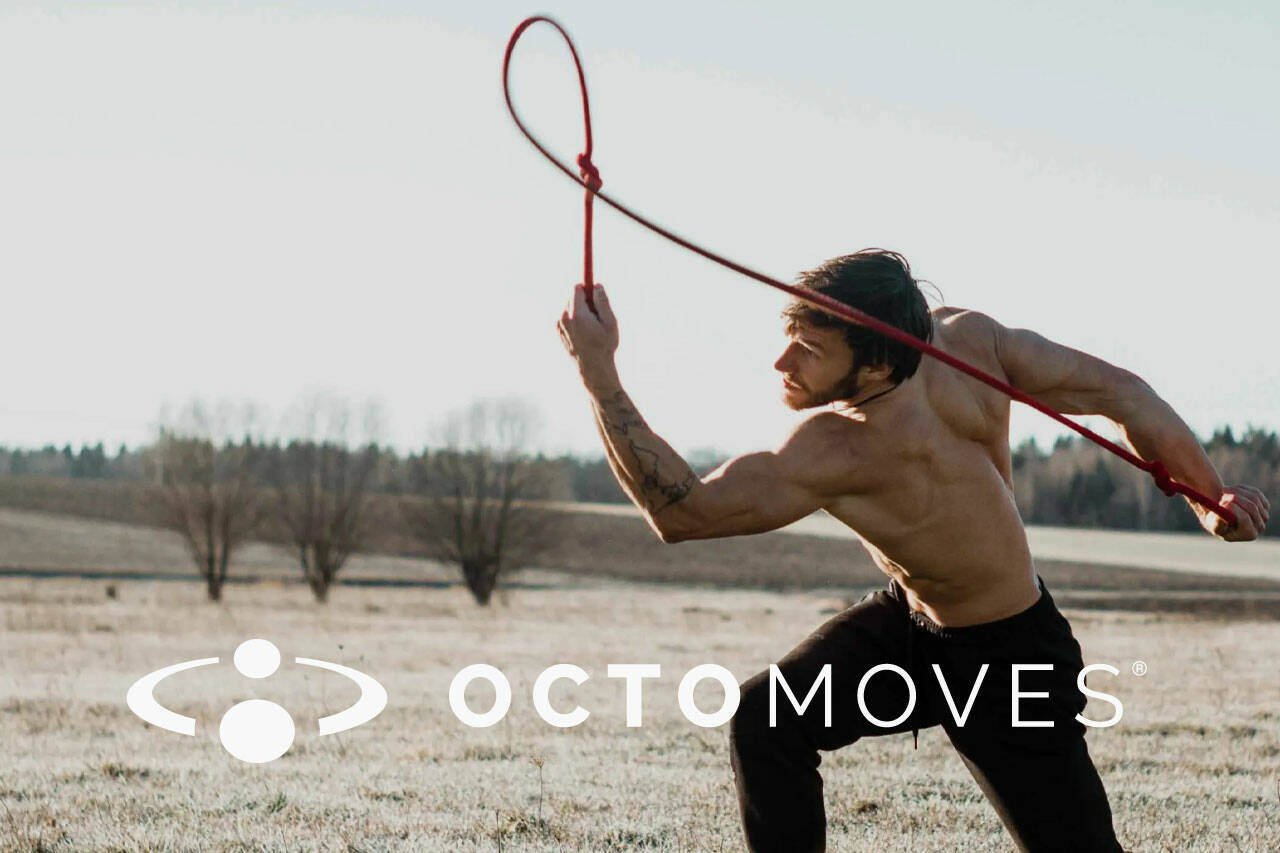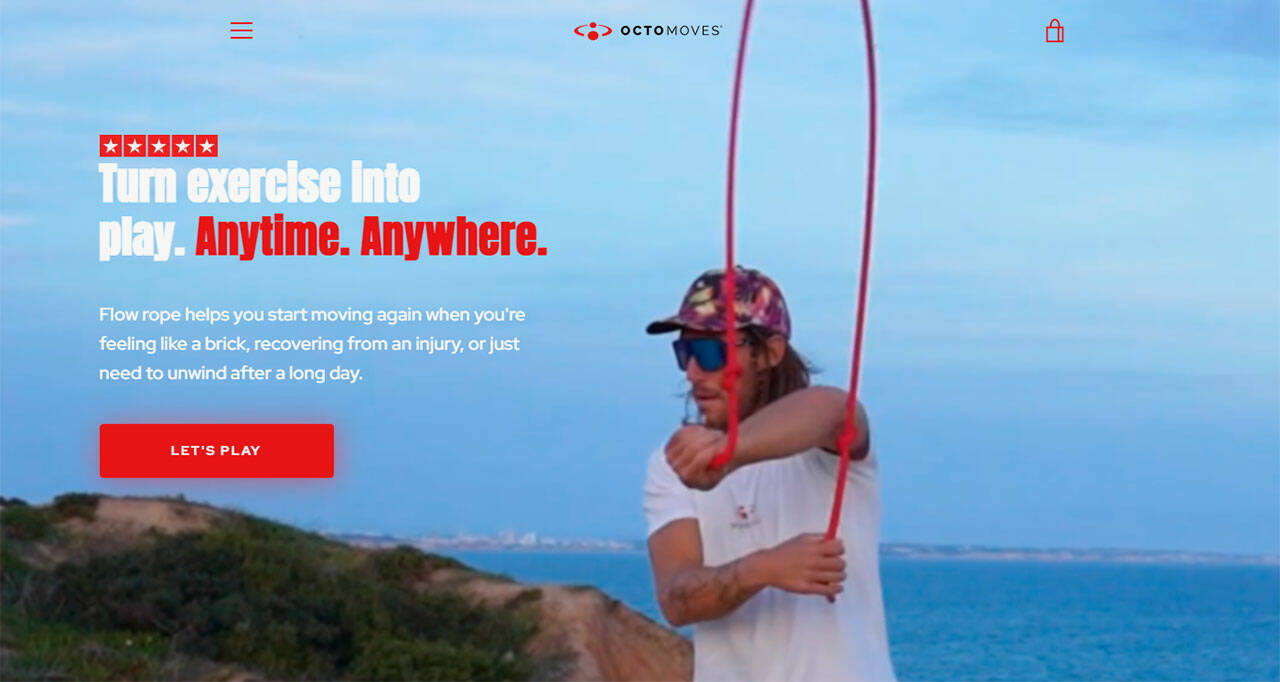What rope training does to your body and the key battle rope benefits and possible drawbacks are explained. Find out more about Octomoves and flow ropes.
You’ve probably skipped rope at least once in your life. If not as an adult, then surely as a child. But jumping rope isn’t the only way to harness the power of ropes to your advantage.
Rope training is an intense exercise you do with heavy-duty ropes. A whole body workout can improve your strength, cardiorespiratory fitness, and athletic performance.
So, what are the battle ropes? Read on to find out what muscles they work and their pros and cons. So, let’s get jumping!
What Are Battle Ropes?
Battle ropes are heavy-duty ropes between 1–2 inches thick and 30 feet or longer. They are often made from braided polyester or natural fibers. You may have noticed them already at your local gym.
Their twisted, multi-strand construction makes them highly resistant to wear and tear. Many will also have non-slip grips at the rope ends to prevent fraying.
Battle ropes may also come with an anchor such as strap anchors or a metal bracket. For many battle rope exercises, you need to anchor the ropes in place.
You can use them for a variety of workouts involving whipping, spiraling, slamming, and waving movements. If Octomoves battle ropes sound versatile to you, they are.
- Thicker ropes (2 inches) are heavier and more challenging to use. They are great for quick and intense rope exercises.
- Narrower ropes (1–1.5 inches) are easier to handle while remaining challenging enough to give you a great workout. You can use them to build endurance.
What Muscles Does Rope Training Work?
Rope exercises are great for your arms, shoulders, upper back, and legs. They can provide full body strength training. More specifically, performing battle rope exercises works especially the following muscles:
- Biceps
- Triceps
- Forearm muscles
- Pectorals
- Abdominal muscles
- Deltoids
- Obliques
- Glutes
- Hamstrings
The exact muscle activation pattern varies depending on the rope exercises you do. But you can count on rope exercises to activate all the major muscle groups in your body.
How Do You Do Battle Rope Exercises?
A typical battle rope exercise begins with you grabbing one end of the anchored rope in each hand.
You can stand with your feet shoulder-width apart or slightly wider. For some exercises, you can go into a quarter squat position with knees slightly bent.
You can then create waves with the ropes, slam the ropes against the ground, and perform other movements. You can also alternate arms and perform Russian twists.
Battle Rope Workout Ideas
You can use battle ropes in so many ways that it’s easy to find a battle rope workout you enjoy. You can create your own workout combining different battle rope exercises.
Here are five battle rope exercises you can do as part of a simple workout:
Lateral whip. Stand with knees slightly bent in a quarter squat position. Bending your elbows slightly, bring the heavy ropes up and then whip them down. Do 10 reps.
Biceps wave. Begin in a squat position with feet hip-width apart and arms extended halfway. Wave the ropes as fast as you can, remaining in the squat position. Aim for a high number of repetitions. You can also do this exercise half kneeling with your left or right leg on the floor.
Jumping power slam. Place your feet hip-width apart and hold the heavy ropes with both hands. Jump and swing the ropes over your right and left hip, and then slam the ropes hard against the ground as you come down to complete a rep. Do 10 reps. To make the exercise harder, after landing, you can go into a deep squat.
Full circle wave. Stand with feet hip-width apart and sideways to the anchor point of the ropes. Grab the ends of the rope in each hand and move your hands in a circular motion in front of you for 10 reps before doing the movement in the opposite direction. Aim for a big circle.
Alternate arms wave squat. Grab your ropes, allowing some slack in them. Move the ropes in alternating waves as you get into a squat position with feet under your shoulders or slightly wider. At the end of the squat, press yourself up through your heels. Keep waving the ropes, alternating arms, and squatting for 10 reps.
As you become used to the battle ropes, you can increase the number of sets and reps.
Tip: A solid stance helps you get started with most rope workouts.
4 Advantages of Rope Training
Why exercise with ropes? Not only because it’s fun and adds variety to your workouts, but because it brings you some significant benefits. Let’s take a closer look at the benefits of a battle rope workout.
Improves cardiorespiratory fitness
With most rope exercises, you get a serious cardio workout. Movements like swinging increase your heart rate and get your blood flowing.
A 2015 study found that 10 minutes of high-intensity training with a rope improves cardiorespiratory fitness.
You can take the cardio benefits you gain from a battle rope workout into other sports. Or simply use rope exercises to start being active. Even if you don’t have all that much time for training.
Burns plenty of calories
With an intense battle rope exercise, you can burn as many as 20 calories per minute. Your heart and muscles work hard to keep you twisting, slamming, and waving the ropes. And that means a serious workout that can help you shed pounds.
At the same time, it doesn’t put stress on your legs. For most battle rope exercises, you’ll be keeping your feet planted on the ground. You can even do some of the exercises seated.
That makes rope workouts ideal for combining with running and other cardio exercises. Alongside a balanced diet low in calories, it can help you lose weight and become fit faster than other workouts.
Improves your athletic performance
A 2018 study found that a battle rope workout can improve aerobic capacity, upper and lower body power, and core muscle endurance.
It can boost your core endurance and jump height. It also improved shooting accuracy in collegiate basketball players.
Participants in a 2022 study who followed a battle rope workout for six weeks could do 7 to 10 more pushups. More specifically, they did battle rope workouts 3 times a week.
Whether you already lift weights or run, battle rope exercises can complement your training workout. It’s also a powerful way to cross-train your entire body or specific muscles.
Provides a full-body workout
We’ve already seen that training with ropes activates most of your upper and lower body muscles, including the core, shoulders, and back. The result can be a great total body workout.
One advantage of battle ropes over other fitness equipment is that you alter movements to target different muscle groups.
If you want to work many different muscles without investing in too much equipment, Octomoves Flow Ropes battle ropes can be a smart choice.
2 Disadvantages of Rope Training
What about the cons of battle rope exercises? Sore muscles and space considerations can create some inconveniences. But they don’t have to be deal breakers.
Requires plenty of space
To exercise with a standard rope, you need a clear path that’s 15 feet long or so. Giant ropes can require 25 feet of space. For the exercise to be effective, you often have to avoid too much slack.
What’s more, slamming the ropes against your home floor isn’t the best idea. Some gym layouts may also not be ideal for training with ropes, either.
One workaround to this problem is to set up the battle ropes in your backyard or driveway. And make sure the pets get out of the way!
Sore muscles and slow recovery
An intense battle rope workout like power slams will leave your muscles sore and your whole body tired. Recovery won’t always happen overnight, so you need to factor in rest days.
This isn’t a problem for runners, for example, since battle rope exercises will strain mostly your upper body muscles.
But if you have several intense strength training workouts in your week, it may slow recovery. However, you can build in enough rest days. Or lighten the intensity of your battle rope workout.
Performing power slams and other intense battle rope exercises can also worsen shoulder problems. If you have a shoulder muscle or joint injury, avoid these exercises until you recover.
Alternatives to Rope Training
What if you don’t have the space for battle ropes? Or can’t do the exercise for whatever reasons?
You can substitute battle rope exercises with other activities that provide compound movements. Or with a series of exercises that can provide a comparable body workout.
Here are some alternative workouts you can try:
Kettlebell swings. In this explosive exercise, you swing a kettlebell from under your legs to face height. The exercise uses all your key muscle groups and increases heart activity. Start with feet slightly wider than shoulders or under shoulders and a slight bend in your knees. You can also do this exercise with one arm.
Burpees. This jump squat exercise combines jumping jacks from a squatting position with pushups. It has similar benefits to battle rope exercises. Landing softly is important. You can also do a deep squat.
Rowing machine. Used at a low resistance level, rowing can recreate the cardio benefits of a battle rope workout.
Medicine ball slams. This power exercise can replace the power slam with heavy ropes. In the starting position, you stand tall with feet under your shoulders, holding a medicine ball over your head. You then slam the ball against the floor with both hands.
Tip: Do some warm-ups such as dynamic stretching and deep squat exercises before doing any of these exercises.
Octomoves as an Alternative Workout Type
What about a battle rope alternative apart from skipping rope? Meet Octomoves.
Octomoves is a fun mobility and coordination exercise that uses a shorter rope called a flow rope. It’s easy to get started with, even if you haven’t trained in a while.
Flow rope turns Octomoves into a low-impact and playful exercise you can do anytime, anywhere. You can choose between different flow ropes starting at 10mm in thickness and 300g in weight.
Octomoves is a versatile exercise you can use to relieve stress, improve your coordination and mobility, meditate, and more. Motions you can make with a flow rope include alternating waves and wide circles.
Next, let’s explore the advantages of Octomoves.
Pros of Octomoves
With Octomoves Flow Ropes, you get more than cardio benefits. It helps you get into shape, recover from injury, relieve stress and anxiety, and boost your focus.
Loosens up stiff muscles and joints and aids recovery
Unlike battle rope exercises, Octomoves is a beginner-friendly workout that brings flow to your movements.
It’s also perfect if you’re recovering after a joint, muscle, or other injury. You’ll start feeling better with the first twist.
Octomoves take your shoulders through their full range of motion and improves their mobility. With a figure-8 pattern, you can release tension from your mid-back, a common result of too much sitting.
Flow roping also engages your core and glutes.
Easy to use
Hold your flow rope in one hand and spin it overhand, from top to bottom. Getting started with Octomoves is as easy as that. You can then try the figure-8 pattern, underhand movements, and more.
Octomoves coordinates the sides of your body and can improve your athletic performance across activities, from running to playing tennis.
Promotes fat loss
Flow roping gets your heart pumping and accelerates your metabolism. You start burning calories from the first movement. The best part is that fat loss with Octomoves doesn’t come at the cost of stress on your bones.
A flow rope is also very portable. You can take it with you to work or on travels and practice in your free moments.
Full-body workout
Octomoves incorporates cardio and strength workouts. More than increasing your heart rate, it activates most of the muscle groups in your body. You’ll also be using your lower body muscles since Octomoves involves dynamic movements.
What’s more, Octomoves helps you train your brain even as you train your body. By encouraging you to develop new movement patterns, it can help you sharpen your focus and boost your productivity in and out of the office.
Reduces stress and anxiety
With flow roping, entering a state of flow is easy. And since you can take it with you into nature, you can use it to enter a quiet meditative state.
Octomoves is a simple and effective way to reduce stress through dynamic movements. It can also increase the time you spend outdoors.
Doesn’t stress your bones or joints
Octomoves is great for cross-training since it doesn’t strain your legs. If you do strength training, you can opt for gentle upper body movements.
You can control the intensity of your flow rope exercise according to your needs. Power up to boost your fitness or tone it down to rest and recuperate.
Challenges of Usage (Octomoves)
Using a flow rope is not without its challenges. While easy to learn, advanced rope flowing calls for good coordination, balance, and mobility.
Existing wrist, arm, elbow, and shoulder injuries
We’ve seen that rope flowing can help you ease your way into being active after an injury. Starting rope flow training involves moving your wrist quickly.
If your wrist was recently injured or is overtaxed because of your strength workouts, any rope exercise may be challenging.
As you can see in this martial intent rope flow video, your arms, elbows, and shoulders also do a lot of work. If your shoulders or arms have sustained a recent injury, give your body time to recover before starting with light movements.
You need space to rope flow
Octoropes are 9 feet in length. That’s considerably shorter than your average battle rope. Nor do flow ropes need anchoring.
Even so, you need space around you to use them. Put another way, you need to go outdoors or to a spacious gym.
In colder weather, you may find using Octomoves outdoors more challenging. But if you work up your courage to go, cold morning speed rope flow training can feel fantastic.
Takeaways of Octomoves Flow Ropes
Battle ropes offer a great full-body exercise with proven cardio, strength, and other benefits. Battle ropes work all major muscle groups, including those on your arms. But you don’t have to slam the ropes to enjoy the benefits of training with a rope.
Kettlebell swings, burpees, and jump rope are just some of the alternatives to battle ropes. An even more fun rope training exercise is Octomoves, which uses rope flow.
Rope flow can unstiffen your body from head to toes while improving your mobility and coordination. It’s easy to get started with, invites calm, and relieves stress even as it upsets your heartbeat.
If you haven’t tried rope flow already, maybe it’s time you did. Visit the official Octomoves Flow Ropes website today to get it while supplies last!
RELATED PRODUCTS:








